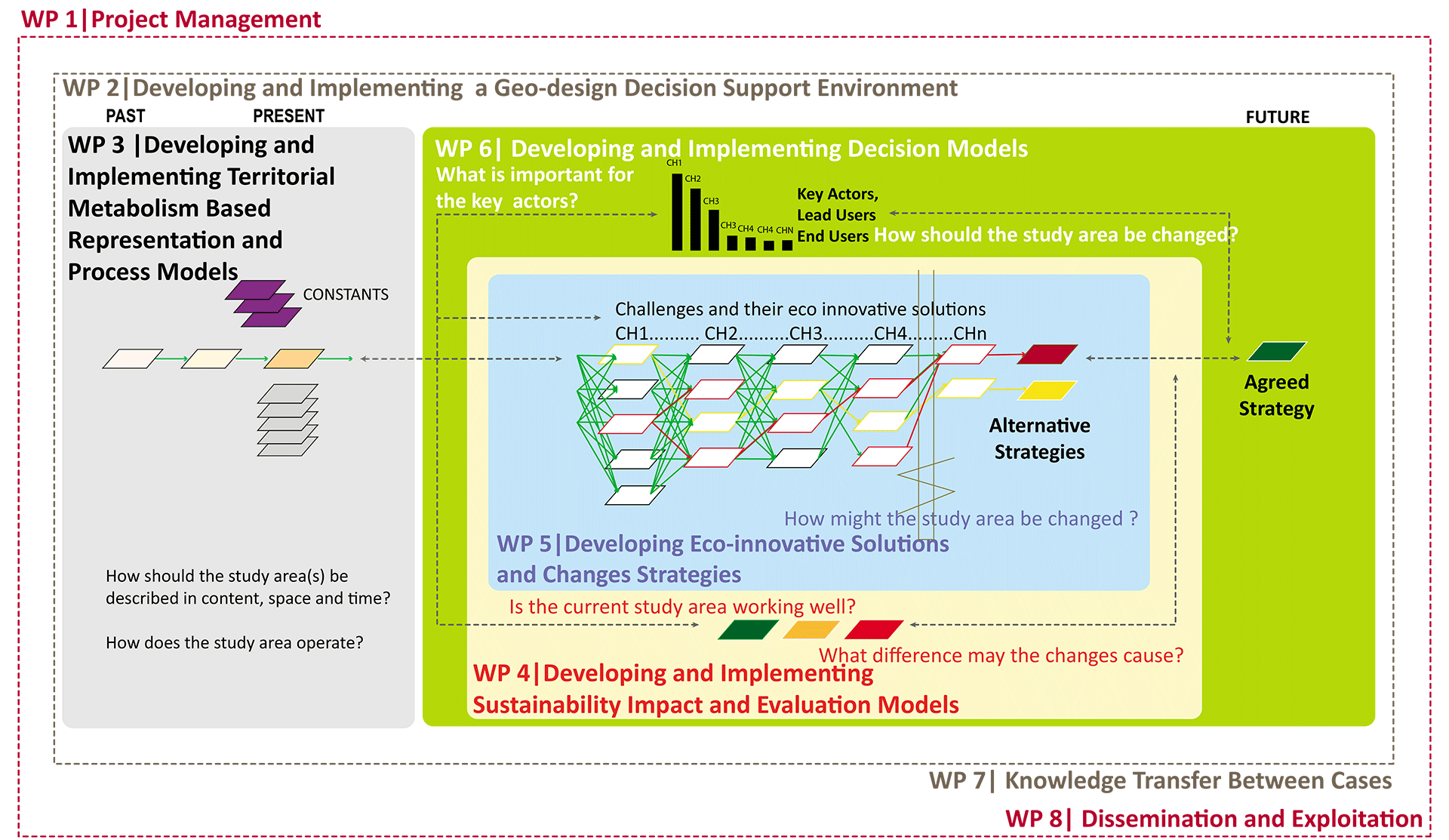REPAiR follows in its structure the six questions and models of the geodesign framework and is organised in two levels (Figure 1). WPs 3 to 6 develop the six models of the geodesign framework for each study area, whereas WPs 1, 2, 7 and 8 manage different aspects across the cases and coordinate activities related to knowledge dissemination and data management.

REPAiR’s approach to developing strategies that strengthen CE builds on the collaboration of several expert teams from industrial ecology, economy, spatial planning, environmental policies and other relevant fields and stakeholders from particular regions. This approach calls for a methodology facilitating regular inter-team interaction in a real world environment. Accordingly, the REPAiR team needs to:
- understand the decision needs of key actors in the study areas;
- specify the concept of urban metabolism to describe the crucial processes in the study area;
- generate manifold ideas for possible changes and engage future users, local stakeholders as well as thematic experts in strategy development;
- develop a framework of indicators to assess these ideas against the current situation;
- develop a framework of knowledge transfer;
- develop data management structures and user interfaces for the GDSE to enable decision makers to assess their decision alternatives quickly.
There are four types of activities in the project, namely (a) research activities, (b) technological innovation, (c) peri-urban living labs and (d) promotion activities. These are tightly interlinked to ensure a quick market uptake of the GDSE, which will foster change and improvement in resource management, and thereby prevent waste generation and promote waste as resource.
a) Research Activities:
The four main research activities are:
- Developing and implementing territorial metabolism models – WP 3
- Developing and implementing evaluation and impact models –WP 4
- Developing and implementing decision models – WP 6
- Develop a knowledge transfer methodology- WP 7
For all thematic WPs, REPAiR uses three dimensions: (1) flows and stocks, (2) place (peri-urban landscape, environmental and spatial quality), and (3) behaviour & governance (organisation, lifestyle, institutions, etc). This allows for a comprehensive analysis and assessment of quantitative and qualitative data, because patterns characterising the processes in the area emerge through the interplay of these three dimensions. They will be investigated at four interrelated scales: (1) local, i.e. the specific peri-urban area; (2) metropolitan – the larger urban area; (3) European; and (4) global.
b) Technological Innovation activities
Technological innovation at REPAiR is mainly in the area of software development for the GDSE. For the software development, REPAiR will follow an iterative and interactive process in which problem formulations and solutions evolve together through collaboration between the different partners, members of the user board, as well as students of the involved faculties. The process will be based on rapid development of prototypes in parallel with pilot tests (for verification & validation), to allow continuous improvement and adaptation with the evolving formulations of the problems and solutions.
The GDSE is built of five modules: data management (DBM), dialogue management (DM), model management (MM), knowledge management (KM), and stakeholder management (SM), see Figure 2. Software, hardware and process-ware have to be developed, tested and implemented.

c) Peri-urban living labs
REPAiR agrees with Ferrao et al. (2013) ‘that we need to begin to redesign parts of the structure that underlies the process of achieving sustainability, based on new ideas from every trace of sustainability we can locate’. Hence, design in its widest sense plays a crucial role in developing strategies for CE. REPAiR organises peri-urban living labs (PULLs), where key actors, representatives of regions, municipalities, corporations, individuals, design professionals, information technologists, scientists and students collaboratively generate new ideas and strategies for the development of CE. WP 5 organised the PULLs and is described in more detail below.
The main aim of the PULLs is to develop strategies for a more circular economy by first generating input for the development of the six models that build the GDSE as well as test the environment of the GDSE itself. The PULLs are the main place and time of transdisciplinary integration within REPAiR. REPAiR integrates activities of ongoing teaching activities at the participating universities and AMS with research conducted in the WPs by consortium partners.
The PULLs will be organised by a Management Board (MB) that will lead them and be responsible for concluding and reporting the results. The different workshops and other interactive and participatory events of all WPs will be integrated in time and place during the PULLs. REPAiR will conduct two different kinds of PULLs: for the pilot studies and the follow up studies.
The key to successfully using the living lab approach for the development of the GDSE is the right choice of study areas; they need to be diverse enough to be representative for most European countries, but also need to be able to test and validate whether the GDSE is flexible enough to be transferable to other contexts, and to detect limits of transferability. Three of the cases are characterised by high recycling rates and low rates of landfilling: Amsterdam (NL), Ghent (BE) and Hamburg (D). The key challenge there is developing a circular economy instead of incinerating waste or exporting it. The other 3 cases, Łódź (PL), Naples (I) and Pécs (H), with lower recycling rates and higher rates of landfills, face parallel challenges of increasing recycling rates and reducing illegal dumping on the way to a CE. The wide array of characteristics within this set of cases (see Figure 3) makes them representative for many other European metropolitan regions.


